Strategic Human Resource Management and Employment Relations Analysis
VerifiedAdded on 2022/11/07
|14
|4112
|475
Report
AI Summary
This report provides an analysis of strategic human resource management (SHRM) and employment relations. It explores the relationship between business strategy and human resource strategy, examining vertical and horizontal integration within HRM. The report critically evaluates and compares three theoretical perspectives of SHRM: the universalist (best-practice), contingency (best-fit), and resource-based view. It also assesses HR practices in performance and reward management systems, detailing specific HR practices and their functions, such as creating performance management systems, monitoring, training, and providing feedback. Furthermore, the report delves into employment relations, examining different theoretical perspectives including Marxist, pluralistic, and unitary approaches, and identifies the key actors within the employment relationship. The changing patterns of employment relations are discussed, and recommendations are provided to improve employee participation and voice within organizations. This document is available on Desklib, a platform offering a wide range of study resources and solved assignments for students.
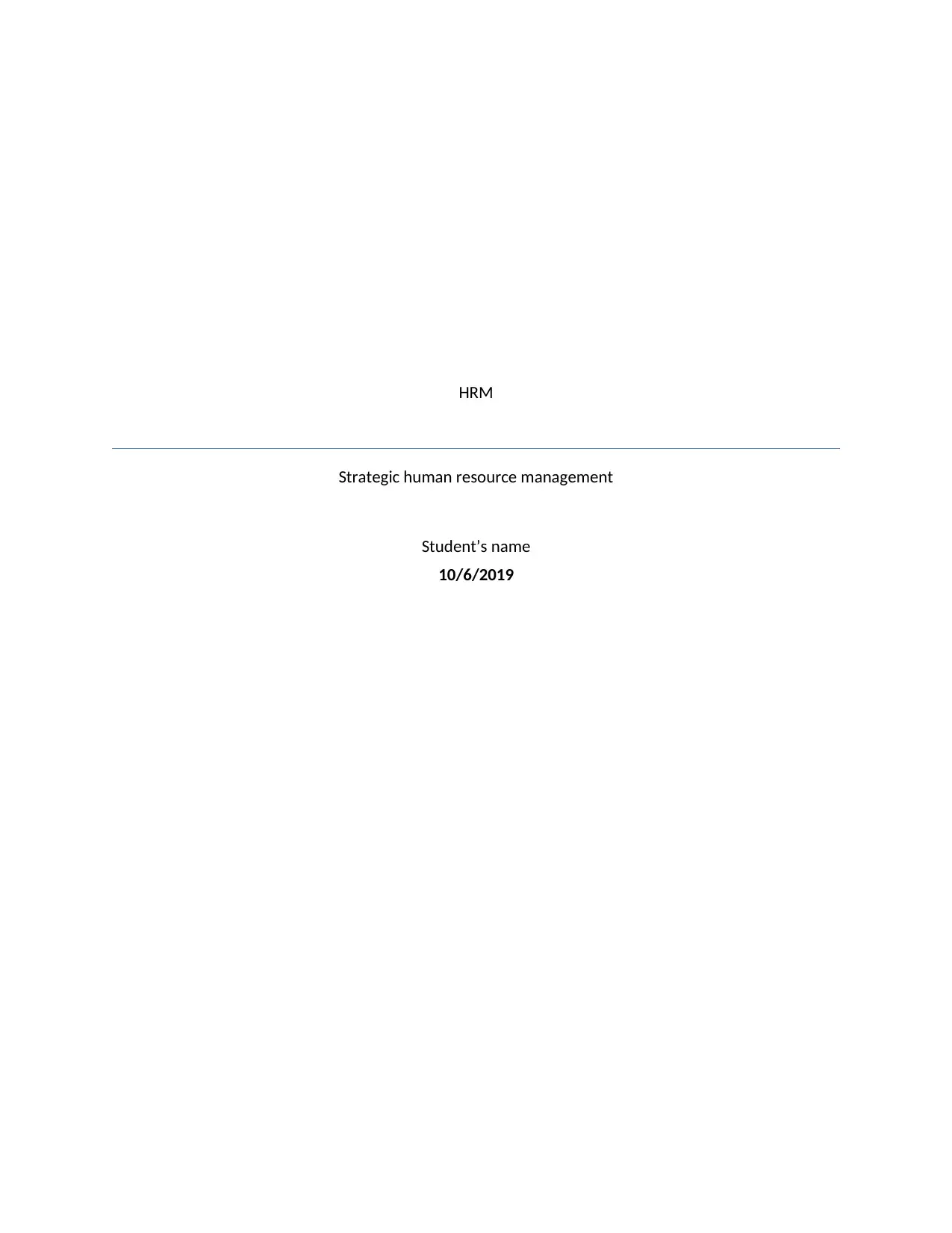
HRM
Strategic human resource management
Student’s name
10/6/2019
Strategic human resource management
Student’s name
10/6/2019
Paraphrase This Document
Need a fresh take? Get an instant paraphrase of this document with our AI Paraphraser
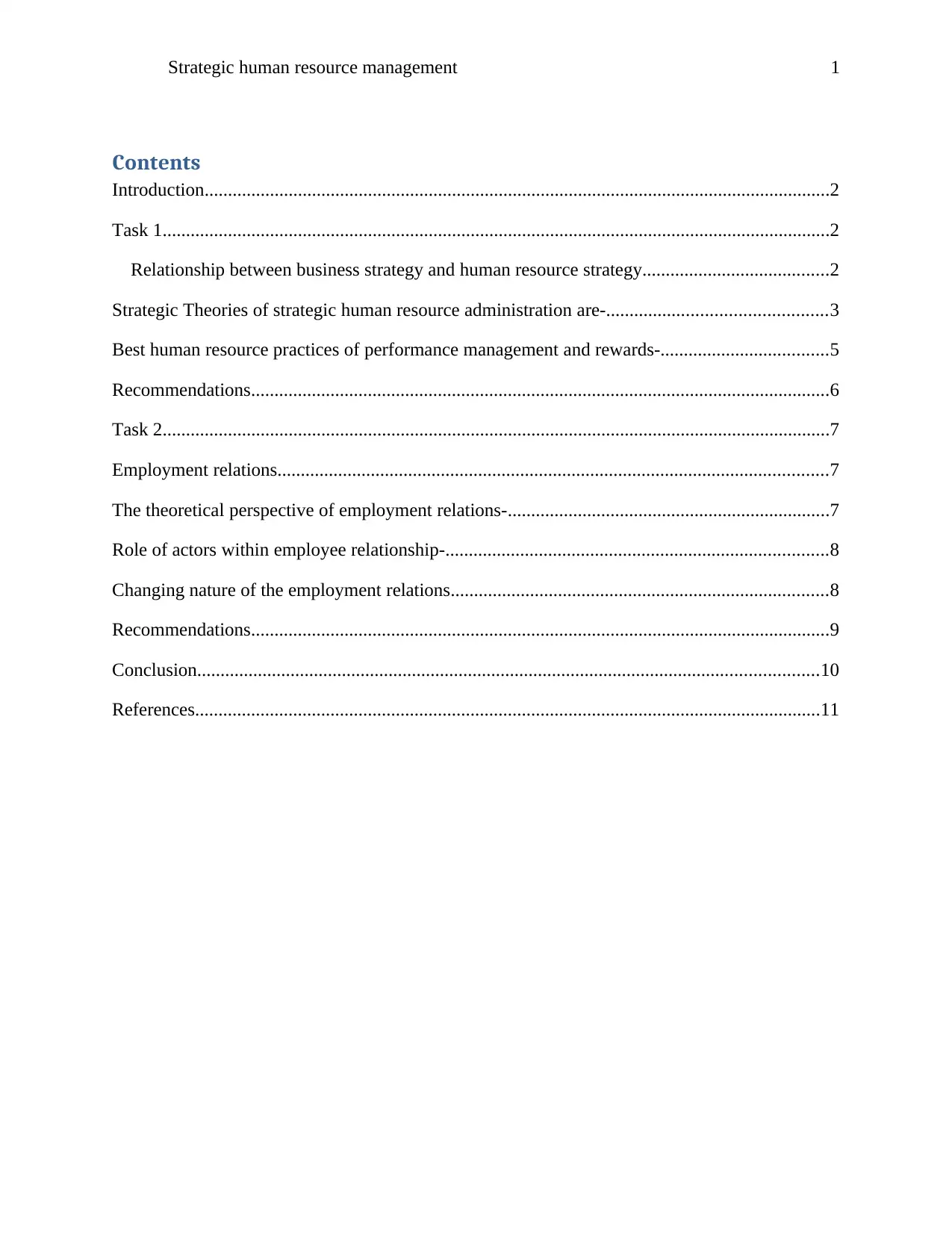
Strategic human resource management 1
Contents
Introduction......................................................................................................................................2
Task 1...............................................................................................................................................2
Relationship between business strategy and human resource strategy........................................2
Strategic Theories of strategic human resource administration are-...............................................3
Best human resource practices of performance management and rewards-....................................5
Recommendations............................................................................................................................6
Task 2...............................................................................................................................................7
Employment relations......................................................................................................................7
The theoretical perspective of employment relations-.....................................................................7
Role of actors within employee relationship-..................................................................................8
Changing nature of the employment relations.................................................................................8
Recommendations............................................................................................................................9
Conclusion.....................................................................................................................................10
References......................................................................................................................................11
Contents
Introduction......................................................................................................................................2
Task 1...............................................................................................................................................2
Relationship between business strategy and human resource strategy........................................2
Strategic Theories of strategic human resource administration are-...............................................3
Best human resource practices of performance management and rewards-....................................5
Recommendations............................................................................................................................6
Task 2...............................................................................................................................................7
Employment relations......................................................................................................................7
The theoretical perspective of employment relations-.....................................................................7
Role of actors within employee relationship-..................................................................................8
Changing nature of the employment relations.................................................................................8
Recommendations............................................................................................................................9
Conclusion.....................................................................................................................................10
References......................................................................................................................................11
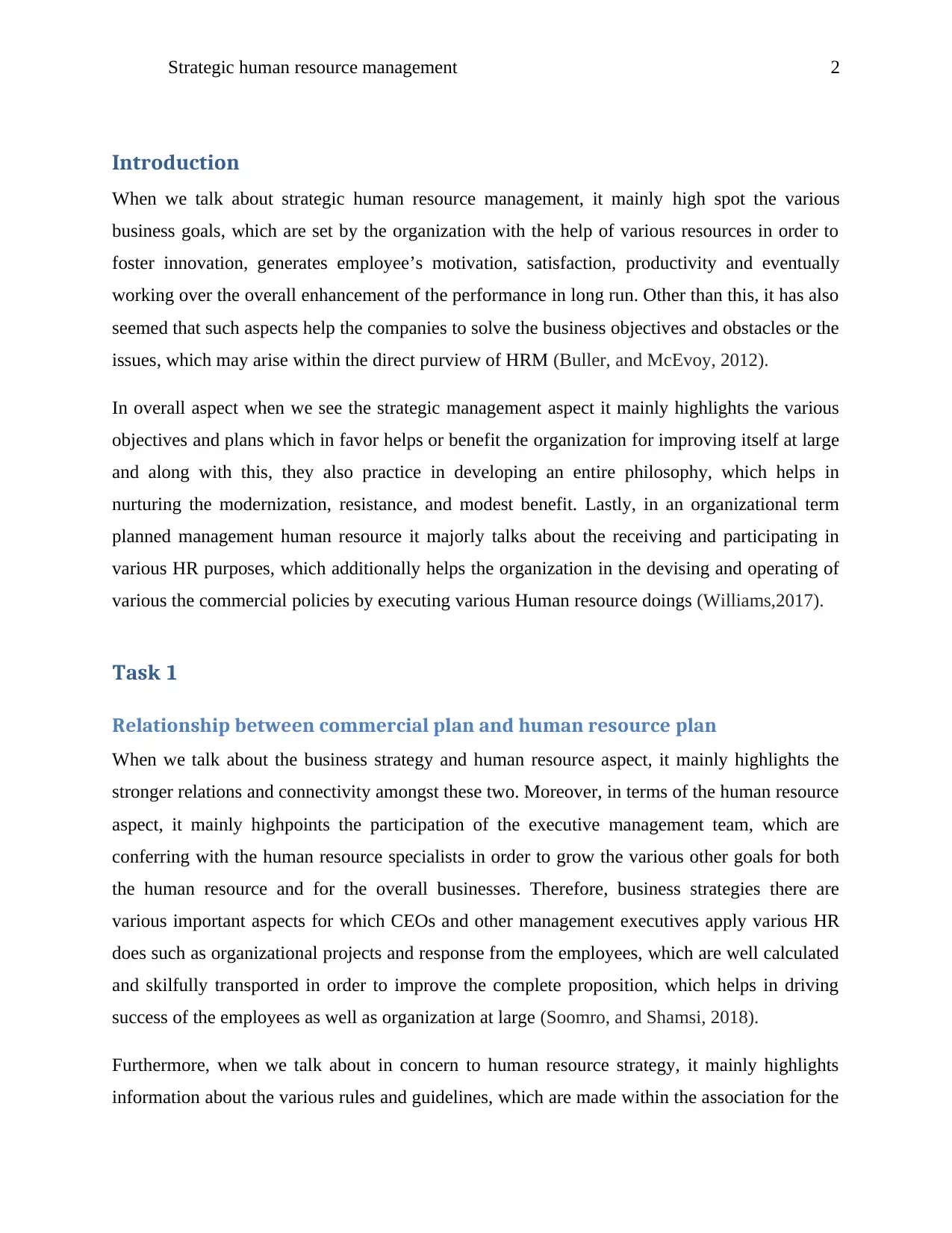
Strategic human resource management 2
Introduction
When we talk about strategic human resource management, it mainly high spot the various
business goals, which are set by the organization with the help of various resources in order to
foster innovation, generates employee’s motivation, satisfaction, productivity and eventually
working over the overall enhancement of the performance in long run. Other than this, it has also
seemed that such aspects help the companies to solve the business objectives and obstacles or the
issues, which may arise within the direct purview of HRM (Buller, and McEvoy, 2012).
In overall aspect when we see the strategic management aspect it mainly highlights the various
objectives and plans which in favor helps or benefit the organization for improving itself at large
and along with this, they also practice in developing an entire philosophy, which helps in
nurturing the modernization, resistance, and modest benefit. Lastly, in an organizational term
planned management human resource it majorly talks about the receiving and participating in
various HR purposes, which additionally helps the organization in the devising and operating of
various the commercial policies by executing various Human resource doings (Williams,2017).
Task 1
Relationship between commercial plan and human resource plan
When we talk about the business strategy and human resource aspect, it mainly highlights the
stronger relations and connectivity amongst these two. Moreover, in terms of the human resource
aspect, it mainly highpoints the participation of the executive management team, which are
conferring with the human resource specialists in order to grow the various other goals for both
the human resource and for the overall businesses. Therefore, business strategies there are
various important aspects for which CEOs and other management executives apply various HR
does such as organizational projects and response from the employees, which are well calculated
and skilfully transported in order to improve the complete proposition, which helps in driving
success of the employees as well as organization at large (Soomro, and Shamsi, 2018).
Furthermore, when we talk about in concern to human resource strategy, it mainly highlights
information about the various rules and guidelines, which are made within the association for the
Introduction
When we talk about strategic human resource management, it mainly high spot the various
business goals, which are set by the organization with the help of various resources in order to
foster innovation, generates employee’s motivation, satisfaction, productivity and eventually
working over the overall enhancement of the performance in long run. Other than this, it has also
seemed that such aspects help the companies to solve the business objectives and obstacles or the
issues, which may arise within the direct purview of HRM (Buller, and McEvoy, 2012).
In overall aspect when we see the strategic management aspect it mainly highlights the various
objectives and plans which in favor helps or benefit the organization for improving itself at large
and along with this, they also practice in developing an entire philosophy, which helps in
nurturing the modernization, resistance, and modest benefit. Lastly, in an organizational term
planned management human resource it majorly talks about the receiving and participating in
various HR purposes, which additionally helps the organization in the devising and operating of
various the commercial policies by executing various Human resource doings (Williams,2017).
Task 1
Relationship between commercial plan and human resource plan
When we talk about the business strategy and human resource aspect, it mainly highlights the
stronger relations and connectivity amongst these two. Moreover, in terms of the human resource
aspect, it mainly highpoints the participation of the executive management team, which are
conferring with the human resource specialists in order to grow the various other goals for both
the human resource and for the overall businesses. Therefore, business strategies there are
various important aspects for which CEOs and other management executives apply various HR
does such as organizational projects and response from the employees, which are well calculated
and skilfully transported in order to improve the complete proposition, which helps in driving
success of the employees as well as organization at large (Soomro, and Shamsi, 2018).
Furthermore, when we talk about in concern to human resource strategy, it mainly highlights
information about the various rules and guidelines, which are made within the association for the
⊘ This is a preview!⊘
Do you want full access?
Subscribe today to unlock all pages.

Trusted by 1+ million students worldwide
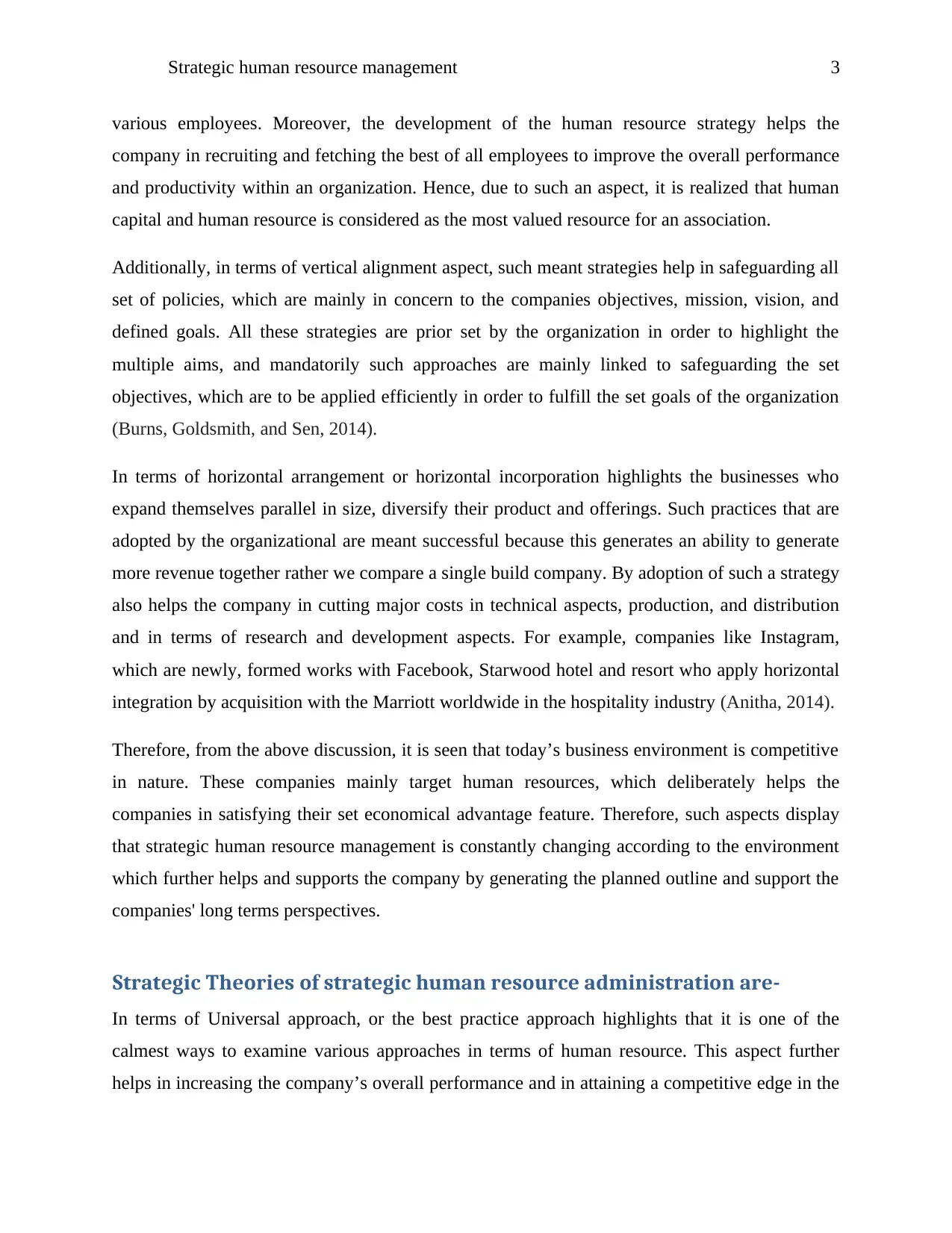
Strategic human resource management 3
various employees. Moreover, the development of the human resource strategy helps the
company in recruiting and fetching the best of all employees to improve the overall performance
and productivity within an organization. Hence, due to such an aspect, it is realized that human
capital and human resource is considered as the most valued resource for an association.
Additionally, in terms of vertical alignment aspect, such meant strategies help in safeguarding all
set of policies, which are mainly in concern to the companies objectives, mission, vision, and
defined goals. All these strategies are prior set by the organization in order to highlight the
multiple aims, and mandatorily such approaches are mainly linked to safeguarding the set
objectives, which are to be applied efficiently in order to fulfill the set goals of the organization
(Burns, Goldsmith, and Sen, 2014).
In terms of horizontal arrangement or horizontal incorporation highlights the businesses who
expand themselves parallel in size, diversify their product and offerings. Such practices that are
adopted by the organizational are meant successful because this generates an ability to generate
more revenue together rather we compare a single build company. By adoption of such a strategy
also helps the company in cutting major costs in technical aspects, production, and distribution
and in terms of research and development aspects. For example, companies like Instagram,
which are newly, formed works with Facebook, Starwood hotel and resort who apply horizontal
integration by acquisition with the Marriott worldwide in the hospitality industry (Anitha, 2014).
Therefore, from the above discussion, it is seen that today’s business environment is competitive
in nature. These companies mainly target human resources, which deliberately helps the
companies in satisfying their set economical advantage feature. Therefore, such aspects display
that strategic human resource management is constantly changing according to the environment
which further helps and supports the company by generating the planned outline and support the
companies' long terms perspectives.
Strategic Theories of strategic human resource administration are-
In terms of Universal approach, or the best practice approach highlights that it is one of the
calmest ways to examine various approaches in terms of human resource. This aspect further
helps in increasing the company’s overall performance and in attaining a competitive edge in the
various employees. Moreover, the development of the human resource strategy helps the
company in recruiting and fetching the best of all employees to improve the overall performance
and productivity within an organization. Hence, due to such an aspect, it is realized that human
capital and human resource is considered as the most valued resource for an association.
Additionally, in terms of vertical alignment aspect, such meant strategies help in safeguarding all
set of policies, which are mainly in concern to the companies objectives, mission, vision, and
defined goals. All these strategies are prior set by the organization in order to highlight the
multiple aims, and mandatorily such approaches are mainly linked to safeguarding the set
objectives, which are to be applied efficiently in order to fulfill the set goals of the organization
(Burns, Goldsmith, and Sen, 2014).
In terms of horizontal arrangement or horizontal incorporation highlights the businesses who
expand themselves parallel in size, diversify their product and offerings. Such practices that are
adopted by the organizational are meant successful because this generates an ability to generate
more revenue together rather we compare a single build company. By adoption of such a strategy
also helps the company in cutting major costs in technical aspects, production, and distribution
and in terms of research and development aspects. For example, companies like Instagram,
which are newly, formed works with Facebook, Starwood hotel and resort who apply horizontal
integration by acquisition with the Marriott worldwide in the hospitality industry (Anitha, 2014).
Therefore, from the above discussion, it is seen that today’s business environment is competitive
in nature. These companies mainly target human resources, which deliberately helps the
companies in satisfying their set economical advantage feature. Therefore, such aspects display
that strategic human resource management is constantly changing according to the environment
which further helps and supports the company by generating the planned outline and support the
companies' long terms perspectives.
Strategic Theories of strategic human resource administration are-
In terms of Universal approach, or the best practice approach highlights that it is one of the
calmest ways to examine various approaches in terms of human resource. This aspect further
helps in increasing the company’s overall performance and in attaining a competitive edge in the
Paraphrase This Document
Need a fresh take? Get an instant paraphrase of this document with our AI Paraphraser
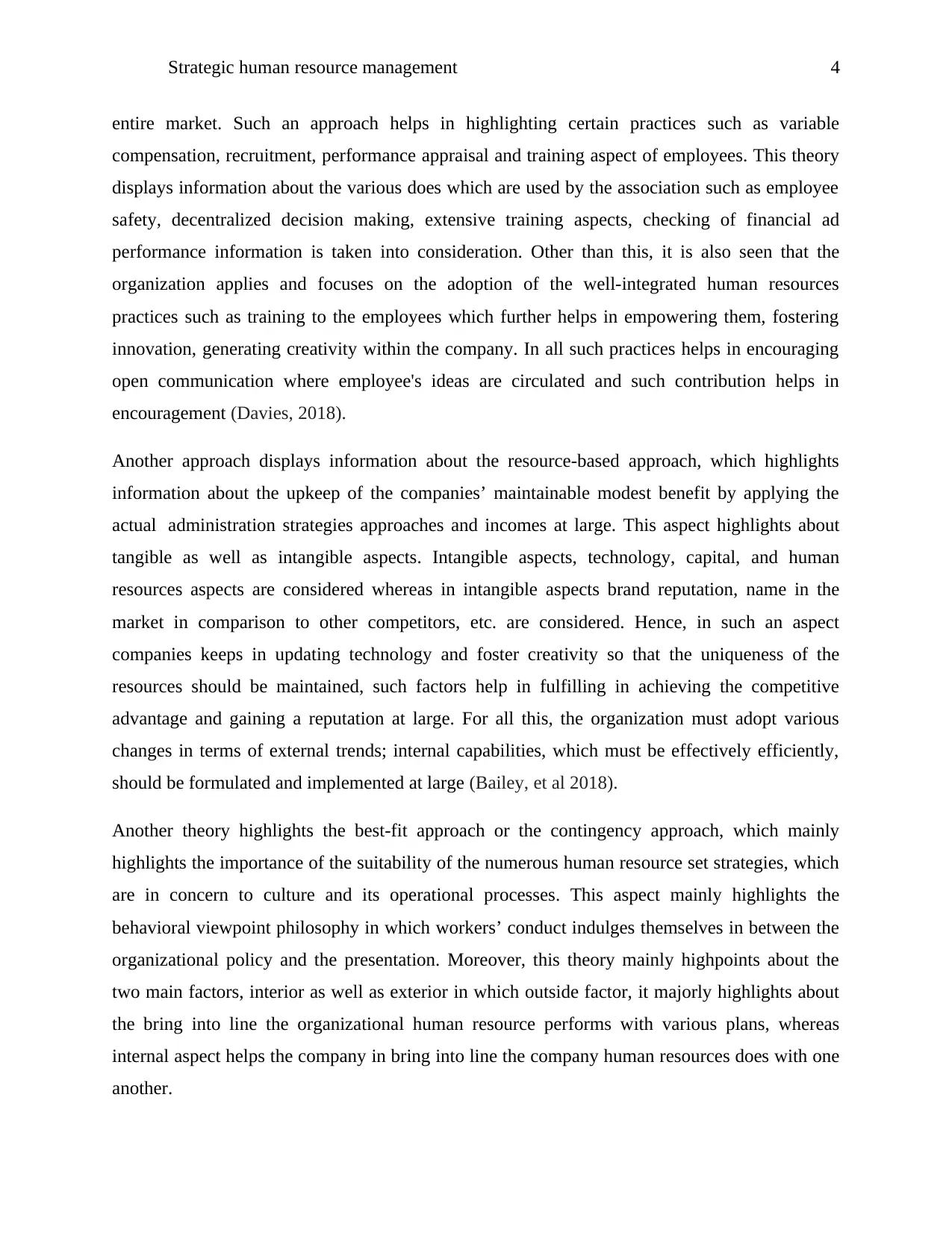
Strategic human resource management 4
entire market. Such an approach helps in highlighting certain practices such as variable
compensation, recruitment, performance appraisal and training aspect of employees. This theory
displays information about the various does which are used by the association such as employee
safety, decentralized decision making, extensive training aspects, checking of financial ad
performance information is taken into consideration. Other than this, it is also seen that the
organization applies and focuses on the adoption of the well-integrated human resources
practices such as training to the employees which further helps in empowering them, fostering
innovation, generating creativity within the company. In all such practices helps in encouraging
open communication where employee's ideas are circulated and such contribution helps in
encouragement (Davies, 2018).
Another approach displays information about the resource-based approach, which highlights
information about the upkeep of the companies’ maintainable modest benefit by applying the
actual administration strategies approaches and incomes at large. This aspect highlights about
tangible as well as intangible aspects. Intangible aspects, technology, capital, and human
resources aspects are considered whereas in intangible aspects brand reputation, name in the
market in comparison to other competitors, etc. are considered. Hence, in such an aspect
companies keeps in updating technology and foster creativity so that the uniqueness of the
resources should be maintained, such factors help in fulfilling in achieving the competitive
advantage and gaining a reputation at large. For all this, the organization must adopt various
changes in terms of external trends; internal capabilities, which must be effectively efficiently,
should be formulated and implemented at large (Bailey, et al 2018).
Another theory highlights the best-fit approach or the contingency approach, which mainly
highlights the importance of the suitability of the numerous human resource set strategies, which
are in concern to culture and its operational processes. This aspect mainly highlights the
behavioral viewpoint philosophy in which workers’ conduct indulges themselves in between the
organizational policy and the presentation. Moreover, this theory mainly highpoints about the
two main factors, interior as well as exterior in which outside factor, it majorly highlights about
the bring into line the organizational human resource performs with various plans, whereas
internal aspect helps the company in bring into line the company human resources does with one
another.
entire market. Such an approach helps in highlighting certain practices such as variable
compensation, recruitment, performance appraisal and training aspect of employees. This theory
displays information about the various does which are used by the association such as employee
safety, decentralized decision making, extensive training aspects, checking of financial ad
performance information is taken into consideration. Other than this, it is also seen that the
organization applies and focuses on the adoption of the well-integrated human resources
practices such as training to the employees which further helps in empowering them, fostering
innovation, generating creativity within the company. In all such practices helps in encouraging
open communication where employee's ideas are circulated and such contribution helps in
encouragement (Davies, 2018).
Another approach displays information about the resource-based approach, which highlights
information about the upkeep of the companies’ maintainable modest benefit by applying the
actual administration strategies approaches and incomes at large. This aspect highlights about
tangible as well as intangible aspects. Intangible aspects, technology, capital, and human
resources aspects are considered whereas in intangible aspects brand reputation, name in the
market in comparison to other competitors, etc. are considered. Hence, in such an aspect
companies keeps in updating technology and foster creativity so that the uniqueness of the
resources should be maintained, such factors help in fulfilling in achieving the competitive
advantage and gaining a reputation at large. For all this, the organization must adopt various
changes in terms of external trends; internal capabilities, which must be effectively efficiently,
should be formulated and implemented at large (Bailey, et al 2018).
Another theory highlights the best-fit approach or the contingency approach, which mainly
highlights the importance of the suitability of the numerous human resource set strategies, which
are in concern to culture and its operational processes. This aspect mainly highlights the
behavioral viewpoint philosophy in which workers’ conduct indulges themselves in between the
organizational policy and the presentation. Moreover, this theory mainly highpoints about the
two main factors, interior as well as exterior in which outside factor, it majorly highlights about
the bring into line the organizational human resource performs with various plans, whereas
internal aspect helps the company in bring into line the company human resources does with one
another.
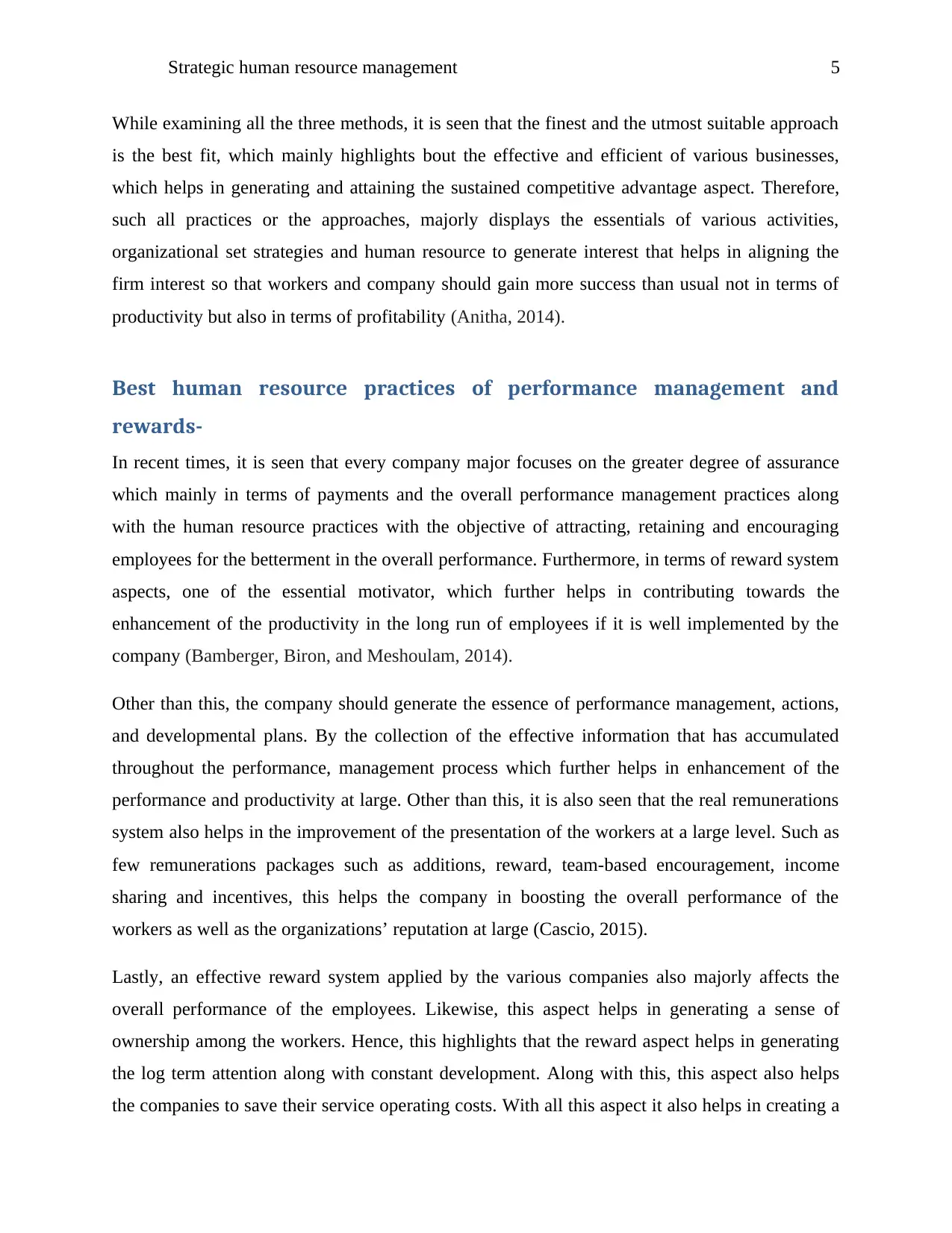
Strategic human resource management 5
While examining all the three methods, it is seen that the finest and the utmost suitable approach
is the best fit, which mainly highlights bout the effective and efficient of various businesses,
which helps in generating and attaining the sustained competitive advantage aspect. Therefore,
such all practices or the approaches, majorly displays the essentials of various activities,
organizational set strategies and human resource to generate interest that helps in aligning the
firm interest so that workers and company should gain more success than usual not in terms of
productivity but also in terms of profitability (Anitha, 2014).
Best human resource practices of performance management and
rewards-
In recent times, it is seen that every company major focuses on the greater degree of assurance
which mainly in terms of payments and the overall performance management practices along
with the human resource practices with the objective of attracting, retaining and encouraging
employees for the betterment in the overall performance. Furthermore, in terms of reward system
aspects, one of the essential motivator, which further helps in contributing towards the
enhancement of the productivity in the long run of employees if it is well implemented by the
company (Bamberger, Biron, and Meshoulam, 2014).
Other than this, the company should generate the essence of performance management, actions,
and developmental plans. By the collection of the effective information that has accumulated
throughout the performance, management process which further helps in enhancement of the
performance and productivity at large. Other than this, it is also seen that the real remunerations
system also helps in the improvement of the presentation of the workers at a large level. Such as
few remunerations packages such as additions, reward, team-based encouragement, income
sharing and incentives, this helps the company in boosting the overall performance of the
workers as well as the organizations’ reputation at large (Cascio, 2015).
Lastly, an effective reward system applied by the various companies also majorly affects the
overall performance of the employees. Likewise, this aspect helps in generating a sense of
ownership among the workers. Hence, this highlights that the reward aspect helps in generating
the log term attention along with constant development. Along with this, this aspect also helps
the companies to save their service operating costs. With all this aspect it also helps in creating a
While examining all the three methods, it is seen that the finest and the utmost suitable approach
is the best fit, which mainly highlights bout the effective and efficient of various businesses,
which helps in generating and attaining the sustained competitive advantage aspect. Therefore,
such all practices or the approaches, majorly displays the essentials of various activities,
organizational set strategies and human resource to generate interest that helps in aligning the
firm interest so that workers and company should gain more success than usual not in terms of
productivity but also in terms of profitability (Anitha, 2014).
Best human resource practices of performance management and
rewards-
In recent times, it is seen that every company major focuses on the greater degree of assurance
which mainly in terms of payments and the overall performance management practices along
with the human resource practices with the objective of attracting, retaining and encouraging
employees for the betterment in the overall performance. Furthermore, in terms of reward system
aspects, one of the essential motivator, which further helps in contributing towards the
enhancement of the productivity in the long run of employees if it is well implemented by the
company (Bamberger, Biron, and Meshoulam, 2014).
Other than this, the company should generate the essence of performance management, actions,
and developmental plans. By the collection of the effective information that has accumulated
throughout the performance, management process which further helps in enhancement of the
performance and productivity at large. Other than this, it is also seen that the real remunerations
system also helps in the improvement of the presentation of the workers at a large level. Such as
few remunerations packages such as additions, reward, team-based encouragement, income
sharing and incentives, this helps the company in boosting the overall performance of the
workers as well as the organizations’ reputation at large (Cascio, 2015).
Lastly, an effective reward system applied by the various companies also majorly affects the
overall performance of the employees. Likewise, this aspect helps in generating a sense of
ownership among the workers. Hence, this highlights that the reward aspect helps in generating
the log term attention along with constant development. Along with this, this aspect also helps
the companies to save their service operating costs. With all this aspect it also helps in creating a
⊘ This is a preview!⊘
Do you want full access?
Subscribe today to unlock all pages.

Trusted by 1+ million students worldwide
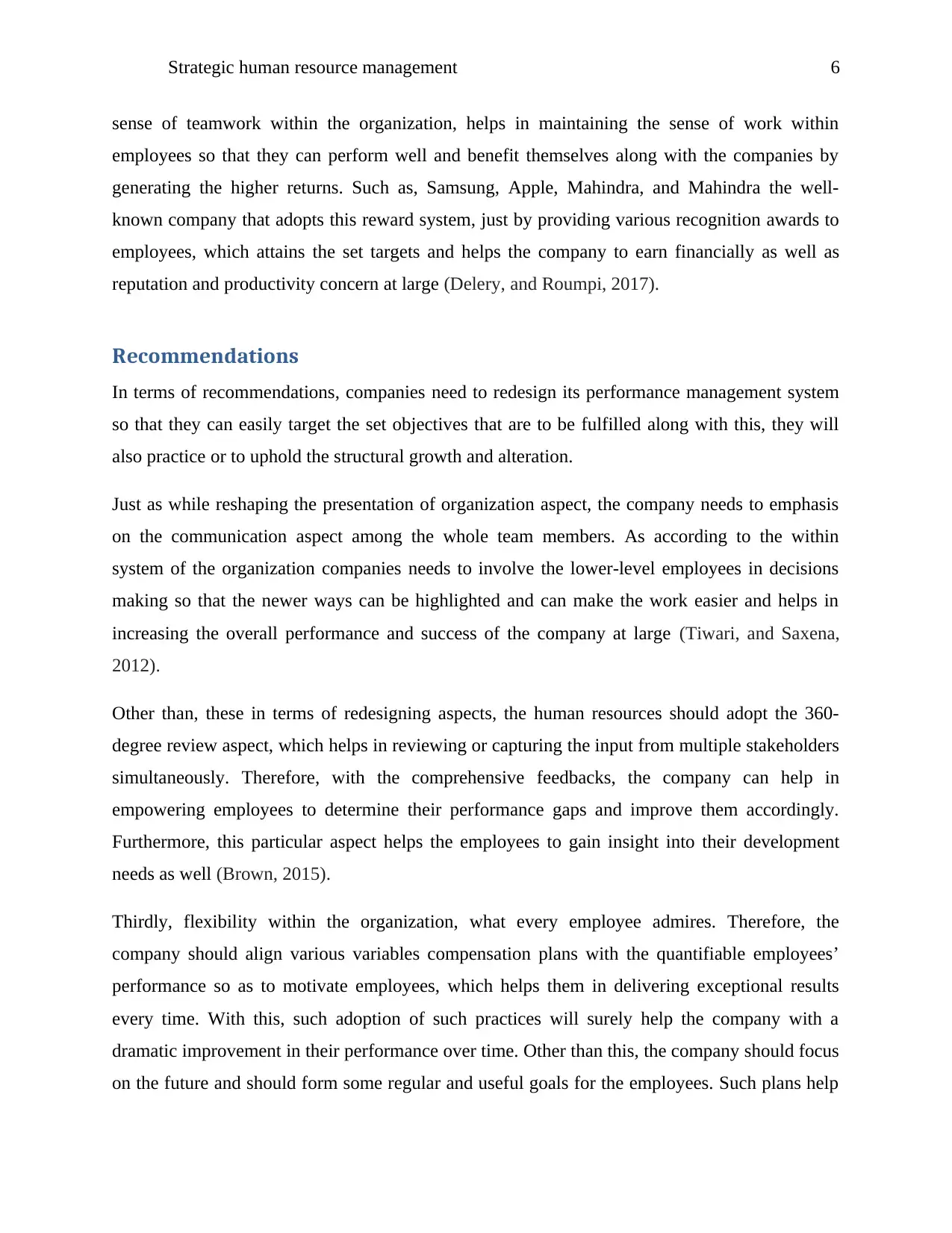
Strategic human resource management 6
sense of teamwork within the organization, helps in maintaining the sense of work within
employees so that they can perform well and benefit themselves along with the companies by
generating the higher returns. Such as, Samsung, Apple, Mahindra, and Mahindra the well-
known company that adopts this reward system, just by providing various recognition awards to
employees, which attains the set targets and helps the company to earn financially as well as
reputation and productivity concern at large (Delery, and Roumpi, 2017).
Recommendations
In terms of recommendations, companies need to redesign its performance management system
so that they can easily target the set objectives that are to be fulfilled along with this, they will
also practice or to uphold the structural growth and alteration.
Just as while reshaping the presentation of organization aspect, the company needs to emphasis
on the communication aspect among the whole team members. As according to the within
system of the organization companies needs to involve the lower-level employees in decisions
making so that the newer ways can be highlighted and can make the work easier and helps in
increasing the overall performance and success of the company at large (Tiwari, and Saxena,
2012).
Other than, these in terms of redesigning aspects, the human resources should adopt the 360-
degree review aspect, which helps in reviewing or capturing the input from multiple stakeholders
simultaneously. Therefore, with the comprehensive feedbacks, the company can help in
empowering employees to determine their performance gaps and improve them accordingly.
Furthermore, this particular aspect helps the employees to gain insight into their development
needs as well (Brown, 2015).
Thirdly, flexibility within the organization, what every employee admires. Therefore, the
company should align various variables compensation plans with the quantifiable employees’
performance so as to motivate employees, which helps them in delivering exceptional results
every time. With this, such adoption of such practices will surely help the company with a
dramatic improvement in their performance over time. Other than this, the company should focus
on the future and should form some regular and useful goals for the employees. Such plans help
sense of teamwork within the organization, helps in maintaining the sense of work within
employees so that they can perform well and benefit themselves along with the companies by
generating the higher returns. Such as, Samsung, Apple, Mahindra, and Mahindra the well-
known company that adopts this reward system, just by providing various recognition awards to
employees, which attains the set targets and helps the company to earn financially as well as
reputation and productivity concern at large (Delery, and Roumpi, 2017).
Recommendations
In terms of recommendations, companies need to redesign its performance management system
so that they can easily target the set objectives that are to be fulfilled along with this, they will
also practice or to uphold the structural growth and alteration.
Just as while reshaping the presentation of organization aspect, the company needs to emphasis
on the communication aspect among the whole team members. As according to the within
system of the organization companies needs to involve the lower-level employees in decisions
making so that the newer ways can be highlighted and can make the work easier and helps in
increasing the overall performance and success of the company at large (Tiwari, and Saxena,
2012).
Other than, these in terms of redesigning aspects, the human resources should adopt the 360-
degree review aspect, which helps in reviewing or capturing the input from multiple stakeholders
simultaneously. Therefore, with the comprehensive feedbacks, the company can help in
empowering employees to determine their performance gaps and improve them accordingly.
Furthermore, this particular aspect helps the employees to gain insight into their development
needs as well (Brown, 2015).
Thirdly, flexibility within the organization, what every employee admires. Therefore, the
company should align various variables compensation plans with the quantifiable employees’
performance so as to motivate employees, which helps them in delivering exceptional results
every time. With this, such adoption of such practices will surely help the company with a
dramatic improvement in their performance over time. Other than this, the company should focus
on the future and should form some regular and useful goals for the employees. Such plans help
Paraphrase This Document
Need a fresh take? Get an instant paraphrase of this document with our AI Paraphraser
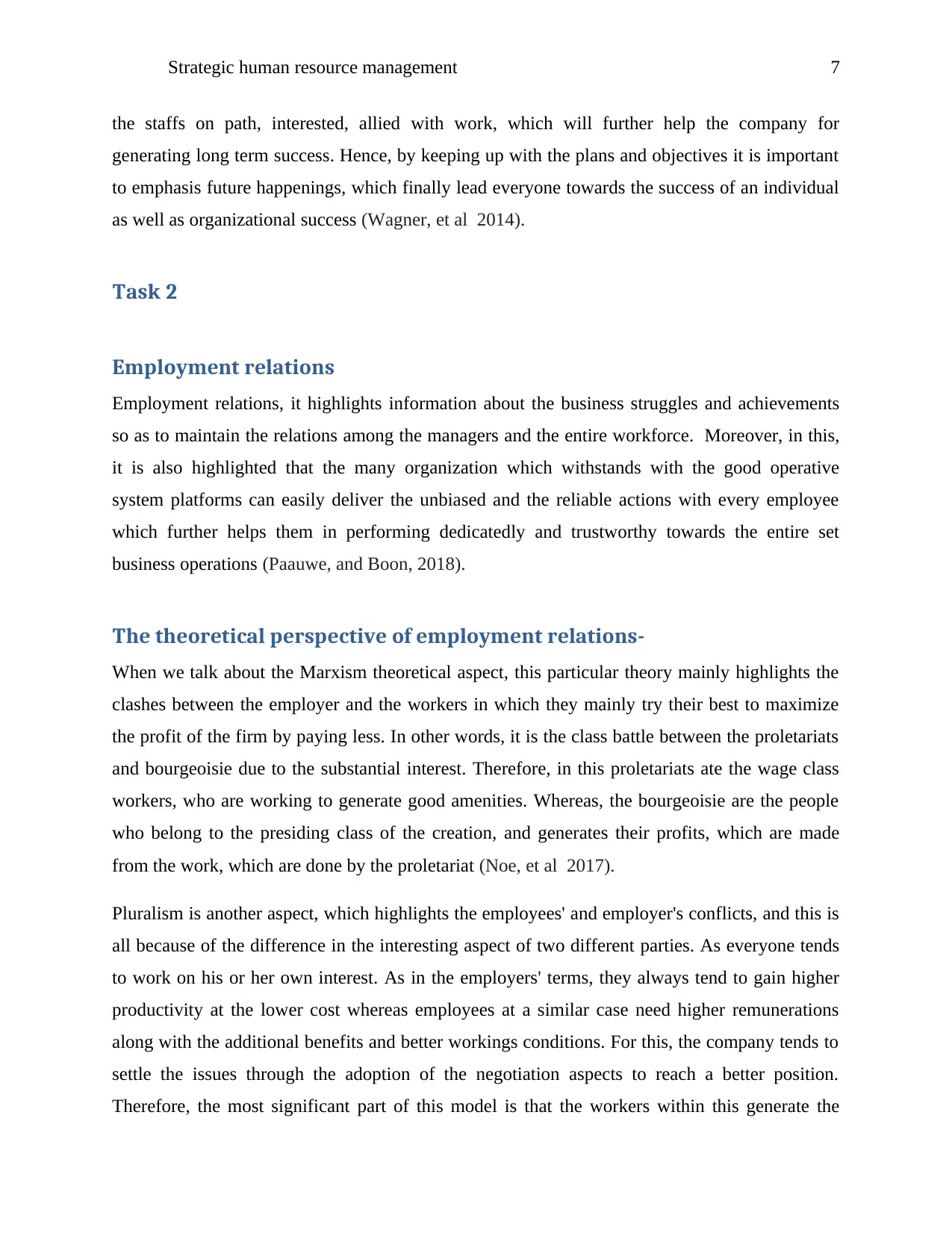
Strategic human resource management 7
the staffs on path, interested, allied with work, which will further help the company for
generating long term success. Hence, by keeping up with the plans and objectives it is important
to emphasis future happenings, which finally lead everyone towards the success of an individual
as well as organizational success (Wagner, et al 2014).
Task 2
Employment relations
Employment relations, it highlights information about the business struggles and achievements
so as to maintain the relations among the managers and the entire workforce. Moreover, in this,
it is also highlighted that the many organization which withstands with the good operative
system platforms can easily deliver the unbiased and the reliable actions with every employee
which further helps them in performing dedicatedly and trustworthy towards the entire set
business operations (Paauwe, and Boon, 2018).
The theoretical perspective of employment relations-
When we talk about the Marxism theoretical aspect, this particular theory mainly highlights the
clashes between the employer and the workers in which they mainly try their best to maximize
the profit of the firm by paying less. In other words, it is the class battle between the proletariats
and bourgeoisie due to the substantial interest. Therefore, in this proletariats ate the wage class
workers, who are working to generate good amenities. Whereas, the bourgeoisie are the people
who belong to the presiding class of the creation, and generates their profits, which are made
from the work, which are done by the proletariat (Noe, et al 2017).
Pluralism is another aspect, which highlights the employees' and employer's conflicts, and this is
all because of the difference in the interesting aspect of two different parties. As everyone tends
to work on his or her own interest. As in the employers' terms, they always tend to gain higher
productivity at the lower cost whereas employees at a similar case need higher remunerations
along with the additional benefits and better workings conditions. For this, the company tends to
settle the issues through the adoption of the negotiation aspects to reach a better position.
Therefore, the most significant part of this model is that the workers within this generate the
the staffs on path, interested, allied with work, which will further help the company for
generating long term success. Hence, by keeping up with the plans and objectives it is important
to emphasis future happenings, which finally lead everyone towards the success of an individual
as well as organizational success (Wagner, et al 2014).
Task 2
Employment relations
Employment relations, it highlights information about the business struggles and achievements
so as to maintain the relations among the managers and the entire workforce. Moreover, in this,
it is also highlighted that the many organization which withstands with the good operative
system platforms can easily deliver the unbiased and the reliable actions with every employee
which further helps them in performing dedicatedly and trustworthy towards the entire set
business operations (Paauwe, and Boon, 2018).
The theoretical perspective of employment relations-
When we talk about the Marxism theoretical aspect, this particular theory mainly highlights the
clashes between the employer and the workers in which they mainly try their best to maximize
the profit of the firm by paying less. In other words, it is the class battle between the proletariats
and bourgeoisie due to the substantial interest. Therefore, in this proletariats ate the wage class
workers, who are working to generate good amenities. Whereas, the bourgeoisie are the people
who belong to the presiding class of the creation, and generates their profits, which are made
from the work, which are done by the proletariat (Noe, et al 2017).
Pluralism is another aspect, which highlights the employees' and employer's conflicts, and this is
all because of the difference in the interesting aspect of two different parties. As everyone tends
to work on his or her own interest. As in the employers' terms, they always tend to gain higher
productivity at the lower cost whereas employees at a similar case need higher remunerations
along with the additional benefits and better workings conditions. For this, the company tends to
settle the issues through the adoption of the negotiation aspects to reach a better position.
Therefore, the most significant part of this model is that the workers within this generate the
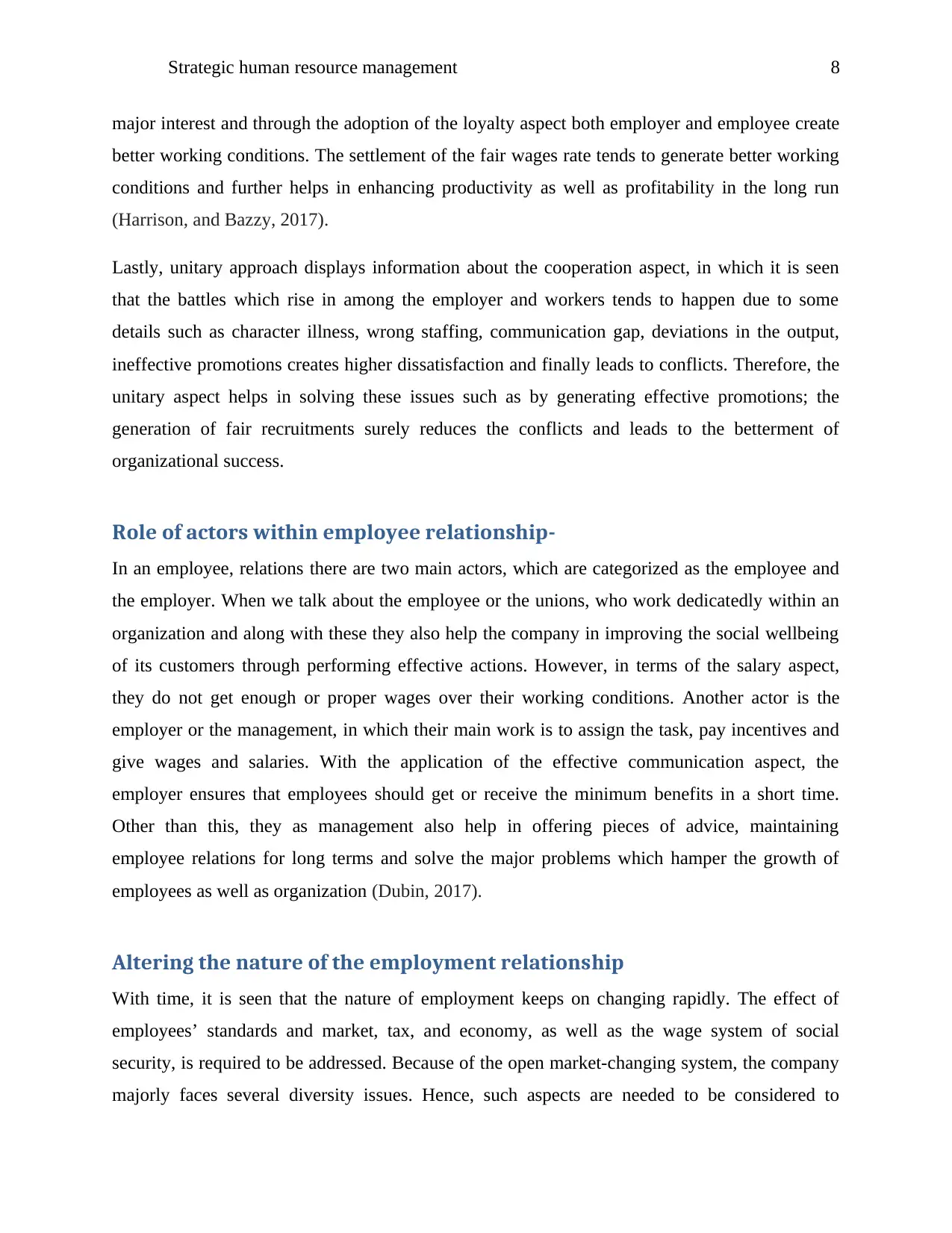
Strategic human resource management 8
major interest and through the adoption of the loyalty aspect both employer and employee create
better working conditions. The settlement of the fair wages rate tends to generate better working
conditions and further helps in enhancing productivity as well as profitability in the long run
(Harrison, and Bazzy, 2017).
Lastly, unitary approach displays information about the cooperation aspect, in which it is seen
that the battles which rise in among the employer and workers tends to happen due to some
details such as character illness, wrong staffing, communication gap, deviations in the output,
ineffective promotions creates higher dissatisfaction and finally leads to conflicts. Therefore, the
unitary aspect helps in solving these issues such as by generating effective promotions; the
generation of fair recruitments surely reduces the conflicts and leads to the betterment of
organizational success.
Role of actors within employee relationship-
In an employee, relations there are two main actors, which are categorized as the employee and
the employer. When we talk about the employee or the unions, who work dedicatedly within an
organization and along with these they also help the company in improving the social wellbeing
of its customers through performing effective actions. However, in terms of the salary aspect,
they do not get enough or proper wages over their working conditions. Another actor is the
employer or the management, in which their main work is to assign the task, pay incentives and
give wages and salaries. With the application of the effective communication aspect, the
employer ensures that employees should get or receive the minimum benefits in a short time.
Other than this, they as management also help in offering pieces of advice, maintaining
employee relations for long terms and solve the major problems which hamper the growth of
employees as well as organization (Dubin, 2017).
Altering the nature of the employment relationship
With time, it is seen that the nature of employment keeps on changing rapidly. The effect of
employees’ standards and market, tax, and economy, as well as the wage system of social
security, is required to be addressed. Because of the open market-changing system, the company
majorly faces several diversity issues. Hence, such aspects are needed to be considered to
major interest and through the adoption of the loyalty aspect both employer and employee create
better working conditions. The settlement of the fair wages rate tends to generate better working
conditions and further helps in enhancing productivity as well as profitability in the long run
(Harrison, and Bazzy, 2017).
Lastly, unitary approach displays information about the cooperation aspect, in which it is seen
that the battles which rise in among the employer and workers tends to happen due to some
details such as character illness, wrong staffing, communication gap, deviations in the output,
ineffective promotions creates higher dissatisfaction and finally leads to conflicts. Therefore, the
unitary aspect helps in solving these issues such as by generating effective promotions; the
generation of fair recruitments surely reduces the conflicts and leads to the betterment of
organizational success.
Role of actors within employee relationship-
In an employee, relations there are two main actors, which are categorized as the employee and
the employer. When we talk about the employee or the unions, who work dedicatedly within an
organization and along with these they also help the company in improving the social wellbeing
of its customers through performing effective actions. However, in terms of the salary aspect,
they do not get enough or proper wages over their working conditions. Another actor is the
employer or the management, in which their main work is to assign the task, pay incentives and
give wages and salaries. With the application of the effective communication aspect, the
employer ensures that employees should get or receive the minimum benefits in a short time.
Other than this, they as management also help in offering pieces of advice, maintaining
employee relations for long terms and solve the major problems which hamper the growth of
employees as well as organization (Dubin, 2017).
Altering the nature of the employment relationship
With time, it is seen that the nature of employment keeps on changing rapidly. The effect of
employees’ standards and market, tax, and economy, as well as the wage system of social
security, is required to be addressed. Because of the open market-changing system, the company
majorly faces several diversity issues. Hence, such aspects are needed to be considered to
⊘ This is a preview!⊘
Do you want full access?
Subscribe today to unlock all pages.

Trusted by 1+ million students worldwide
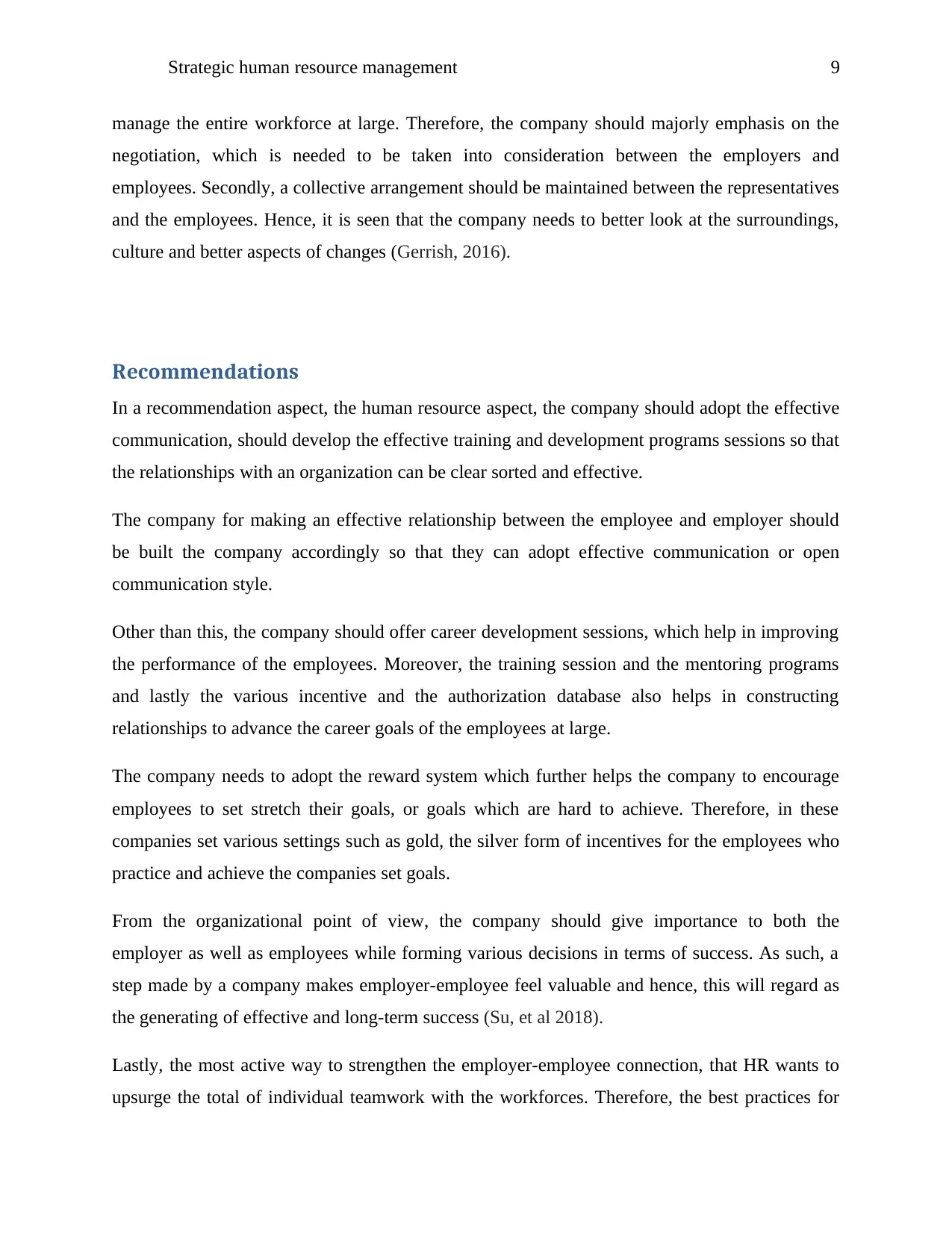
Strategic human resource management 9
manage the entire workforce at large. Therefore, the company should majorly emphasis on the
negotiation, which is needed to be taken into consideration between the employers and
employees. Secondly, a collective arrangement should be maintained between the representatives
and the employees. Hence, it is seen that the company needs to better look at the surroundings,
culture and better aspects of changes (Gerrish, 2016).
Recommendations
In a recommendation aspect, the human resource aspect, the company should adopt the effective
communication, should develop the effective training and development programs sessions so that
the relationships with an organization can be clear sorted and effective.
The company for making an effective relationship between the employee and employer should
be built the company accordingly so that they can adopt effective communication or open
communication style.
Other than this, the company should offer career development sessions, which help in improving
the performance of the employees. Moreover, the training session and the mentoring programs
and lastly the various incentive and the authorization database also helps in constructing
relationships to advance the career goals of the employees at large.
The company needs to adopt the reward system which further helps the company to encourage
employees to set stretch their goals, or goals which are hard to achieve. Therefore, in these
companies set various settings such as gold, the silver form of incentives for the employees who
practice and achieve the companies set goals.
From the organizational point of view, the company should give importance to both the
employer as well as employees while forming various decisions in terms of success. As such, a
step made by a company makes employer-employee feel valuable and hence, this will regard as
the generating of effective and long-term success (Su, et al 2018).
Lastly, the most active way to strengthen the employer-employee connection, that HR wants to
upsurge the total of individual teamwork with the workforces. Therefore, the best practices for
manage the entire workforce at large. Therefore, the company should majorly emphasis on the
negotiation, which is needed to be taken into consideration between the employers and
employees. Secondly, a collective arrangement should be maintained between the representatives
and the employees. Hence, it is seen that the company needs to better look at the surroundings,
culture and better aspects of changes (Gerrish, 2016).
Recommendations
In a recommendation aspect, the human resource aspect, the company should adopt the effective
communication, should develop the effective training and development programs sessions so that
the relationships with an organization can be clear sorted and effective.
The company for making an effective relationship between the employee and employer should
be built the company accordingly so that they can adopt effective communication or open
communication style.
Other than this, the company should offer career development sessions, which help in improving
the performance of the employees. Moreover, the training session and the mentoring programs
and lastly the various incentive and the authorization database also helps in constructing
relationships to advance the career goals of the employees at large.
The company needs to adopt the reward system which further helps the company to encourage
employees to set stretch their goals, or goals which are hard to achieve. Therefore, in these
companies set various settings such as gold, the silver form of incentives for the employees who
practice and achieve the companies set goals.
From the organizational point of view, the company should give importance to both the
employer as well as employees while forming various decisions in terms of success. As such, a
step made by a company makes employer-employee feel valuable and hence, this will regard as
the generating of effective and long-term success (Su, et al 2018).
Lastly, the most active way to strengthen the employer-employee connection, that HR wants to
upsurge the total of individual teamwork with the workforces. Therefore, the best practices for
Paraphrase This Document
Need a fresh take? Get an instant paraphrase of this document with our AI Paraphraser
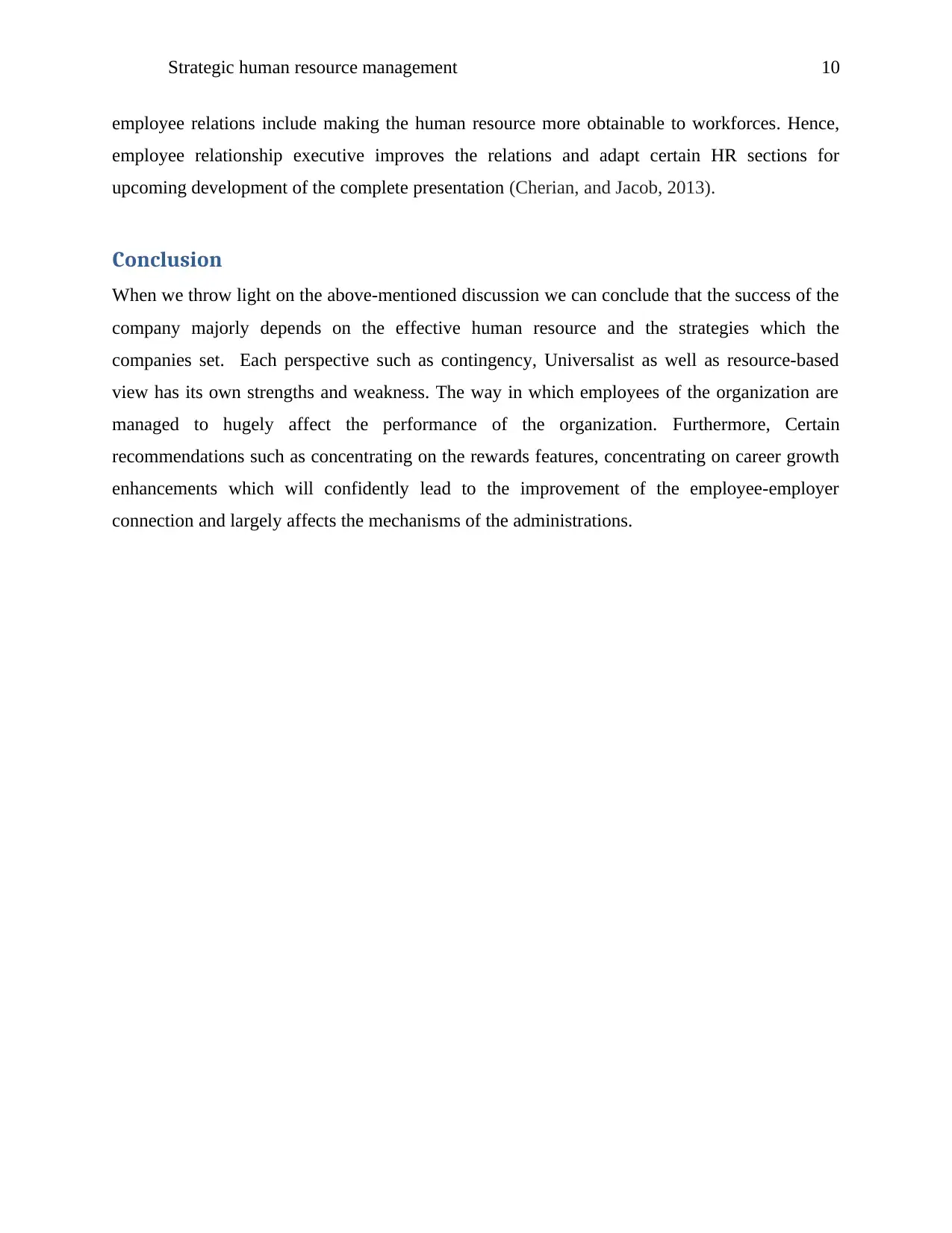
Strategic human resource management 10
employee relations include making the human resource more obtainable to workforces. Hence,
employee relationship executive improves the relations and adapt certain HR sections for
upcoming development of the complete presentation (Cherian, and Jacob, 2013).
Conclusion
When we throw light on the above-mentioned discussion we can conclude that the success of the
company majorly depends on the effective human resource and the strategies which the
companies set. Each perspective such as contingency, Universalist as well as resource-based
view has its own strengths and weakness. The way in which employees of the organization are
managed to hugely affect the performance of the organization. Furthermore, Certain
recommendations such as concentrating on the rewards features, concentrating on career growth
enhancements which will confidently lead to the improvement of the employee-employer
connection and largely affects the mechanisms of the administrations.
employee relations include making the human resource more obtainable to workforces. Hence,
employee relationship executive improves the relations and adapt certain HR sections for
upcoming development of the complete presentation (Cherian, and Jacob, 2013).
Conclusion
When we throw light on the above-mentioned discussion we can conclude that the success of the
company majorly depends on the effective human resource and the strategies which the
companies set. Each perspective such as contingency, Universalist as well as resource-based
view has its own strengths and weakness. The way in which employees of the organization are
managed to hugely affect the performance of the organization. Furthermore, Certain
recommendations such as concentrating on the rewards features, concentrating on career growth
enhancements which will confidently lead to the improvement of the employee-employer
connection and largely affects the mechanisms of the administrations.
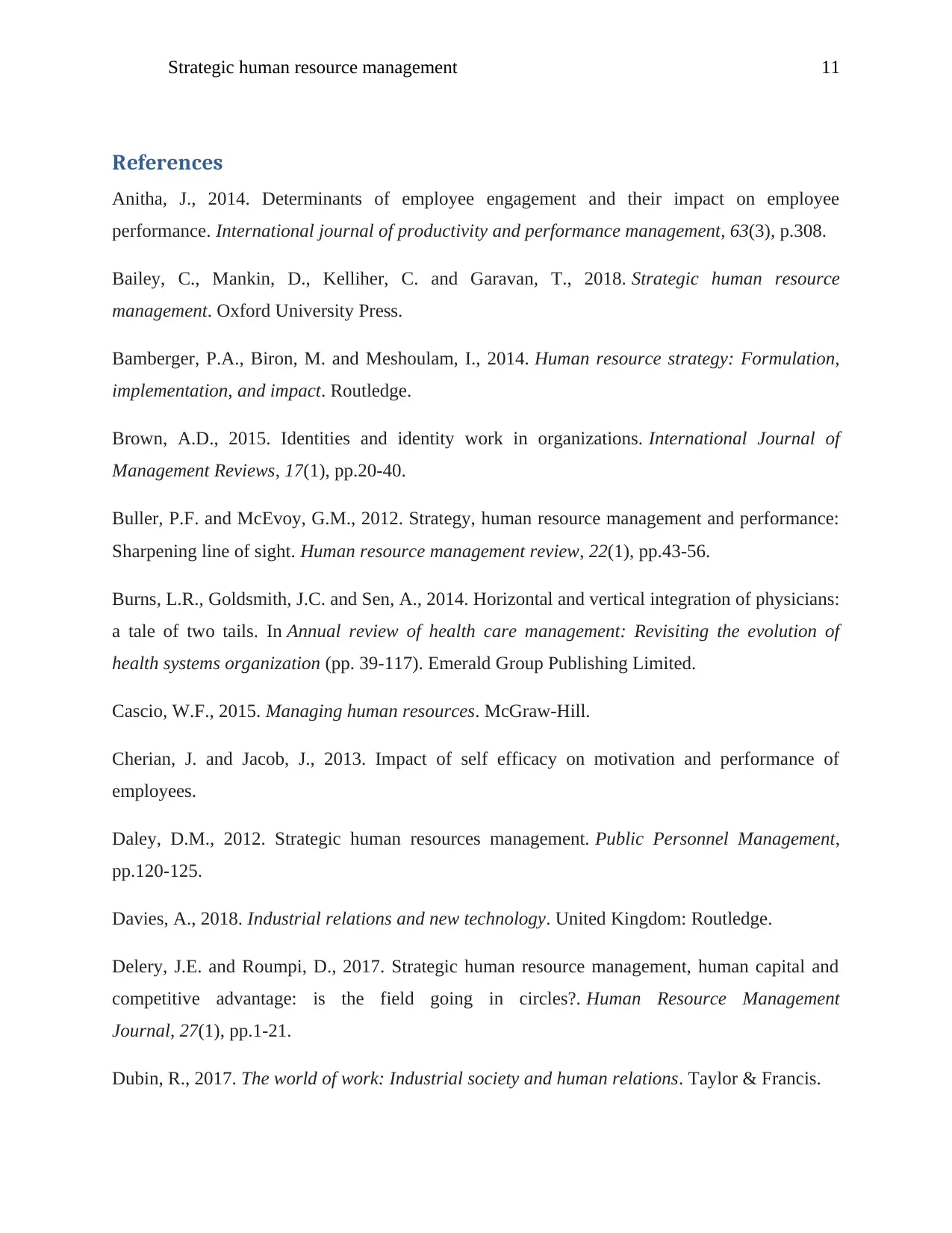
Strategic human resource management 11
References
Anitha, J., 2014. Determinants of employee engagement and their impact on employee
performance. International journal of productivity and performance management, 63(3), p.308.
Bailey, C., Mankin, D., Kelliher, C. and Garavan, T., 2018. Strategic human resource
management. Oxford University Press.
Bamberger, P.A., Biron, M. and Meshoulam, I., 2014. Human resource strategy: Formulation,
implementation, and impact. Routledge.
Brown, A.D., 2015. Identities and identity work in organizations. International Journal of
Management Reviews, 17(1), pp.20-40.
Buller, P.F. and McEvoy, G.M., 2012. Strategy, human resource management and performance:
Sharpening line of sight. Human resource management review, 22(1), pp.43-56.
Burns, L.R., Goldsmith, J.C. and Sen, A., 2014. Horizontal and vertical integration of physicians:
a tale of two tails. In Annual review of health care management: Revisiting the evolution of
health systems organization (pp. 39-117). Emerald Group Publishing Limited.
Cascio, W.F., 2015. Managing human resources. McGraw-Hill.
Cherian, J. and Jacob, J., 2013. Impact of self efficacy on motivation and performance of
employees.
Daley, D.M., 2012. Strategic human resources management. Public Personnel Management,
pp.120-125.
Davies, A., 2018. Industrial relations and new technology. United Kingdom: Routledge.
Delery, J.E. and Roumpi, D., 2017. Strategic human resource management, human capital and
competitive advantage: is the field going in circles?. Human Resource Management
Journal, 27(1), pp.1-21.
Dubin, R., 2017. The world of work: Industrial society and human relations. Taylor & Francis.
References
Anitha, J., 2014. Determinants of employee engagement and their impact on employee
performance. International journal of productivity and performance management, 63(3), p.308.
Bailey, C., Mankin, D., Kelliher, C. and Garavan, T., 2018. Strategic human resource
management. Oxford University Press.
Bamberger, P.A., Biron, M. and Meshoulam, I., 2014. Human resource strategy: Formulation,
implementation, and impact. Routledge.
Brown, A.D., 2015. Identities and identity work in organizations. International Journal of
Management Reviews, 17(1), pp.20-40.
Buller, P.F. and McEvoy, G.M., 2012. Strategy, human resource management and performance:
Sharpening line of sight. Human resource management review, 22(1), pp.43-56.
Burns, L.R., Goldsmith, J.C. and Sen, A., 2014. Horizontal and vertical integration of physicians:
a tale of two tails. In Annual review of health care management: Revisiting the evolution of
health systems organization (pp. 39-117). Emerald Group Publishing Limited.
Cascio, W.F., 2015. Managing human resources. McGraw-Hill.
Cherian, J. and Jacob, J., 2013. Impact of self efficacy on motivation and performance of
employees.
Daley, D.M., 2012. Strategic human resources management. Public Personnel Management,
pp.120-125.
Davies, A., 2018. Industrial relations and new technology. United Kingdom: Routledge.
Delery, J.E. and Roumpi, D., 2017. Strategic human resource management, human capital and
competitive advantage: is the field going in circles?. Human Resource Management
Journal, 27(1), pp.1-21.
Dubin, R., 2017. The world of work: Industrial society and human relations. Taylor & Francis.
⊘ This is a preview!⊘
Do you want full access?
Subscribe today to unlock all pages.

Trusted by 1+ million students worldwide
1 out of 14
Related Documents
Your All-in-One AI-Powered Toolkit for Academic Success.
+13062052269
info@desklib.com
Available 24*7 on WhatsApp / Email
![[object Object]](/_next/static/media/star-bottom.7253800d.svg)
Unlock your academic potential
Copyright © 2020–2025 A2Z Services. All Rights Reserved. Developed and managed by ZUCOL.





